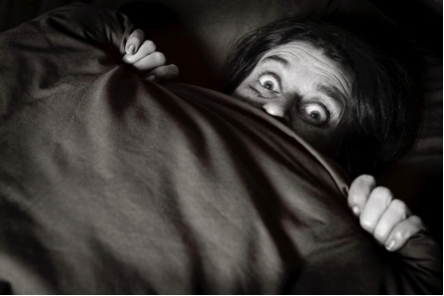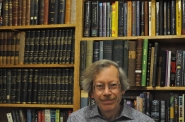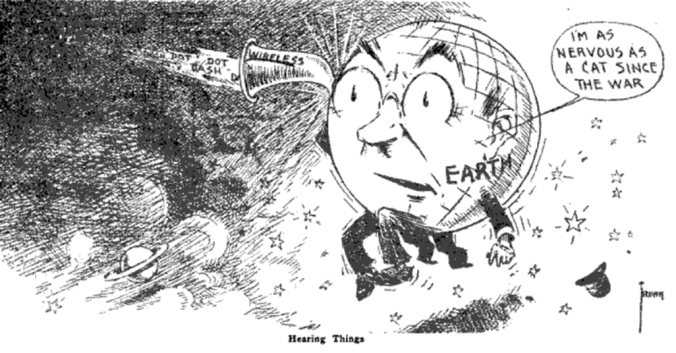
An interesting article by Les Carpenter that demonstrates that sometimes one sees what one wants to see.

An interesting article by Les Carpenter that demonstrates that sometimes one sees what one wants to see.

The Wellcome Collection – a free museum and library “exploring health, life and our place in the world” and funded by the Wellcome Trust – has recently posted a small review of the history of sleep paralysis. Sleep paralysis is a “sleep disorder in which the body is temporarily immobilised at the moment of waking or the moment of falling asleep. It is a minor, yet common, body/mind malfunction that upwards of 50% of the population claims to have experienced at least once in their lifetime.”
UFO researchers are likely most familiar with the phenomenon as it relates to claims of alien abduction. Social scientists and clinicians have often argued that individuals claiming to have had such experiences were in fact experiencing a bout of sleep paralysis that, after the fact, was transformed into a story of extraterrestrial assault.
Check out the site for some interesting video footage as well.

With the 70th anniversary of Kenneth Arnold’s famous “flying saucer” sighting fast upon us (24 June), we likely can expect a number of public reflections over the coming weeks on the Arnold case and the history of UFOs in general.
Veteran UFO researchers Vicente-Juan Ballester Olmos and Thomas E. Bullard have taken the opportunity to share their thoughts on the subject. Both have spent many years examining the evidence and collaborating with ufologists. They both speak of the great enthusiasm they had when they first started following the UFO phenomenon, but both admit – to varying degrees – that the venture appears to have lost much of its steam.

Vicente-Juan Ballester Olmos
Olmos puts it in rather stark terms:
Ufology not only fails to advance, it is a vicious circle. Today we see UFO news publicized on the internet with the same old images of lens flares or aircraft contrails that seemed strange in the 1950s. Because there are no academic or authoritative criteria universally accepted, and no hard evidence that exists as a certainty, past mistakes recur over and over. Ufology is immersed in a loop that never ends.

Thomas E. Bullard
Bullard, however, remains more sanguine about the work:
The reason behind these consistencies might be cultural influence or investigator bias, but actual observation in contrast to imagination might also be the cause. At least the possibility is worth exploring. So many IFO reports in the sample, so many human errors and shortcomings in descriptions plague the record that they threaten to smother the signal from the very much smaller body of UFOs. In the past good minds have had to work with bad data limited in both quantity and quality, and the disappointing results come as no surprise. Today we have much larger samples and data of better quality to escape the garbage in-garbage out problem that dogged earlier efforts. I see reason to believe that some distinctive consistencies in the phenomenon may yet be forthcoming, and that reliance on quality cases as the database will reveal those consistencies in sharper relief. At least the effort should be made before we give up the spaceship.
In any event, their exchange of views makes for fascinating reading and testifies to the hold that the UFO phenomenon has historically had on many observers.

The podcast “Somewhere in the Skies” is a project of ufologist/UFO journalist Ryan Sprague. The latest episode features an interview he conducted with me a short while ago. Among other things, we discuss how I became interested in the history of UFOs, how science and ufology have related to one another, and what I am working on these days.
To my thinking, conversations like these are an essential part of the work of historians. As I have said before, I make no claims to being a ufologist. I am decidedly an outsider looking in (with all the advantages and shortcomings that come with that). But, from my perspective at least, sharing ideas, interests, and findings with those active in the field can only enhance and help refine all our research ventures.

The folks over at the History of Emotions Blog, run by the Queen Mary Centre for the History of the Emotions have just posted a small piece I have written entitled “UFOs and the Historians.” In it, I ask why it is that academic historians have been remarkably uninterested in the world of UFOs, and I discuss what kinds of contributions I believe the field of history can make to research on the subject.

For those of you living in or visiting London in early May, I will be there to give a series of talks on the history of the UFO and alien contact phenomenon. My talk “Belief in the Age of Suspense: The Changing Emotional Landscape of the UFO” is a public event that will be held on May 4 at 6:30 pm at The Horse Hospital. The event is sponsored by the Queen Mary Centre for the History of the Emotion. Do join us, if you can!

Over the decades, many witnesses of UFOs did not report seeing actual flying machines. Rather, they reported seeing unusual and/or brightly colored lights in the sky.

In some cases, their experiences inspired them to reproduce these lights in the form of drawing and paintings.

What you see here are some drawings and watercolors made by residents in the Soviet Union in 1989. Among other things, I think they demonstrate that the aesthetic aspects of the UFO phenomenon have been all-too-often neglected by those studying it.

(From the collection of the Archives for the Unexplained)
If intelligent aliens exist and they were trying to communicate remotely with the inhabitants of earth, would we have the technical capabilities to detect their signals? This question, of course, has preoccupied both ufologists and researchers associated with the the Search for Extraterrestrial Intelligence (SETI). Since the early 1960s, radio telescope technology has played the key role in how academic astronomers have attempted to address this question.
But even before the first reports of “flying saucers” in 1947, there were a number of prominent figures who believed it possible to recognize and possibly decipher messages from intelligent aliens. The key, it was believed, was radio waves.
By the early part of the twentieth century, it was widely believed that planets in our solar system – most particularly, Mars and Venus – were in all likelihood inhabited by extraterrestrial civilizations. In 1901, inventor Nikola Tesla (1856-1943) announced that he had encountered odd electrical disturbances in his lab, “with such a clear suggestion of number and order” that he believed they could only be considered signals from Mars. “The feeling is constantly growing on me,” he explained, “that I had been the first to hear the greeting of one planet to another. A purpose was behind these electrical signals.” (1)

From: The Wireless Age, 7 (March 1920)
Years later, radio inventor Guglielmo Marconi (1874-1937) claimed to have had a similar experience, convinced that in 1919 he too had intercepted messages from Mars. A year later, Marconi reported that his wireless instruments were “occasionally [getting] very queer sounds and indications, which might come from somewhere outside the earth.” While he conceded that he had not “the slightest proof of their origin,” when asked if the signals might be made by another planet trying to communicate with earth, he replied, “I would not rule out the possibility of this…” Mars was widely seen as the likeliest candidate. And while the notion of Martian radio signals was greeted by some engineers and scientists at the time to be little more than wild speculation, others believed the possibility was worth serious study. (2)

The interest in the possibility of using radio technology to hear communications from Martians eventually culminated in a remarkable event in 1924. American astronomer David Peck Todd (1855-1939) had earlier argued that if there were indeed inhabitants on Mars, they might well try to communicate with Earth when the planets were relatively close to one another. On 21 August 1924, this occurred. And in preparation, a “National Radio Silence Day” was promoted throughout the United States. Owners were asked to keep radios silent for five minutes every hour so that a radio receiver at the U.S. Naval Observatory, lifted in a dirigible three kilometers off the ground, could be used to listen for any signals coming from the red planet. Todd and a navy admiral led the program, while an army cryptographer was on hand to translate any messages received. In the end, however, no signals were detected. (3)

1. Florence Raulin Certeau, “Fraction of Civilizations That Develop a Technology That Releases Detectable Signs of Their Existence into Space, fc, pre-1961″ in The Drake Equation: Estimating the Prevalence of Extraterrestrial Life Through the Ages, ed. Douglas A. Vakoch and Matthew F. Dowd, (Cambridge: Cambridge University Press, 2015), 219-220.
2. “Interplanetary Radio Signals? Varied Views on the Question Whether Inhabitant of Mars Have Been Trying to Signal Us by Radio,” The Wireless Age, 7 (March 1920): 11-15.
3. Certeau, “Fraction,” 221.

The Washington Post has recently published a piece on a new catalogue of UFO literature from the 1940s, 1950s, and 1960s compiled by science fiction writer Jack Womack, entitled …Flying Saucers are Real!
I have not yet had a chance to look at the book, but it appears that for those of us who share an interest in the history of the UFO phenomenon, many of the usual canonical suspects appear in the volume.


Especially exciting is the news that the Georgetown University library has acquired Womack’s collection and will be mounting an exhibit featuring works from it some time in 2017. According to the website Boo-Hooray:
Womack’s collection contains books, typescripts, pamphlets, tracts and magazines published primarily from 1948 to 1980. Totaling 242 individual items, the collection includes most of the major 1950s works on flying saucers, the works of all major contactees, bibliographies, compilations of so-called photographs, and a number of publications from the Saucerian Press. 19 of the books in the collection are inscribed or signed by their authors. Several books have supporting letters, ephemera, and press materials laid in.


Portrait of the Martian landscape based on the reports of medium “Hélène Smith” (1900). All figures are from publicdomainreview.org
Since World War II, stories of encounters with extraterrestrials have generally revolved around tales of alien space travelers visiting earth in technologically advanced aircrafts. But there were reports of alien encounters before the modern age of rockets and human space exploration. While more contemporary accounts have portrayed earth’s inhabitants as passive observers of the actions of technically superior extraterrestrials, encounter stories before the 1940s generally emphasized the active efforts of certain “gifted” individuals who were capable of initiating communication with aliens. At around the turn of the 20th century, these individuals tended to be people who claimed to have special powers allowing them to leave their bodies and spiritually communicate with and visit alien worlds (not unlike spiritualists at the time who claimed to be able to talk with the dead).
Not surprisingly, perhaps, these encounter tales offer a very different portrait of extraterrestrial life from that of contactees during the second half of the 20th century. One such example is the case of the medium “Hélène Smith” (real name Catherine Müller), who was born in 1861 and died in 1929. Among other things, Smith claimed to have visited Mars, offering up her own descriptions of the Martian landscape.

She also met and conversed with Martian inhabitants as well.

Unlike the contactees of the space age – who mostly speak of communicating with aliens telepathically – Smith learned what she said was the Martian language, and she provided examples of Martian script.

Smith’s teachings and work were studied for five years by psychologist Théodore Flournoy (1854-1920). He published his findings in 1900 under the English title From India to Planet Mars: A Study of a Case of Somnambulism. You can access a free copy of the book here.